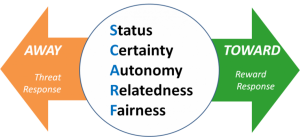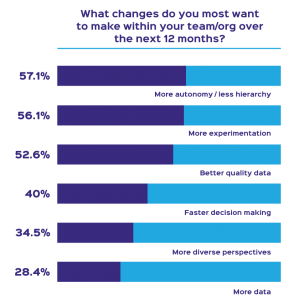
04 Nov Using Your Brain to Lead: An Analysis of Rock’s SCARF Model
“One of the tests of leadership is the ability to recognize a problem before it becomes an emergency.” – Arnold H. Glasow
In 2008, cofounder of the NeuroLeadership Institute David Rock presented the SCARF Model in his paper “SCARF: A Brain-Based Model for Collaborating With and Influencing Others“. His interest in neuroscience and leadership led him to develop the model, which is based around five social domains that are known to activate the threat and reward responses we’ve relied on for physical survival since the beginning of human history.
If you’re familiar with human psychology and behavior, you know that we naturally strive to minimize threats and maximize rewards in our daily lives. There’s a simple reason for this – when we perform well and feel accomplished, dopamine, a feel-good chemical is released in our brains. When we perform poorly or feel threatened, cortisol, a stress hormone, is released.
 How does this apply to leadership?
How does this apply to leadership?
Here’s the thing – the threats we experience aren’t limited to physical threats. Social acceptance is highly beneficial to our survival, so we’ve evolved to take threats to our status very seriously. For better or worse, our brains experience the workplace as a social system – I’m sure you can think of a time or two you felt your social standing was challenged at work and you react emotionally instantaneously, often without much conscious thought.
As you can see from the graphic on the right, the five social domains examined in the SCARF model are status, certainty, autonomy, relatedness, and fairness. If we feel threatened in any one of these domains, our bodies enter fight-or-flight mode, leading us to make poor decisions and become less effective employees overall. We lose focus, struggle to communicate clearly, and our problem solving abilities are severely reduced.
These reactions are instinctual, so if you want to become an effective leader, you’ll have to understand what causes these reactions to occur and how you should interact with your employees to keep them feeling secure and productive. Leaders that operate off of this model can better prepare employees to work collaboratively and create an environment in which everyone’s talents are utilized to the fullest extent.
In this article we’ll check out the five social domains examined in Rock’s SCARF Model, including examples of how you can work with your employees to ensure that they feel valued and motivated in the workplace.
Status – our sense of personal worth
As social creatures we’re constantly evaluating our standing compared to others; we exist and operate within complex hierarchies, and our sense of worth is largely determined by where we stand within a hierarchy. Not everyone can be top dog, making competition and conflict a part of daily life, especially within an organization.
Effective leaders minimize perceived threats and conflict by:
- Giving regular praise, explaining what each person brings to the table
- Assigning key tasks to all members
- Asking for their opinions and perspectives

Certainty – our ability to predict the future
When we know what to expect, we feel safe. When we’re uncertain about a situation, we put all of our energy into making sense of what’s going on around us. Sometimes a bit of uncertainty keeps us sharp and on our toes, but too much can lead to decreased employee engagement and poor performance. (img source)
In order to get the most from your team, give them a sense of certainty by:
- Being clear with your expectations
- Updating them on a regular basis with any changes within your business
- Break down complex processes into simpler, more digestible steps
Autonomy – our sense of control over our lives
To work at maximum capacity, your team needs to know that you trust them to get the job done right on their own. If you’ve had a job where your manager watched your every movement waiting for you to slip up, you likely weren’t motivated to give your best effort.
A recent poll by Medium showed that more autonomy in the workplace is the number one change employees would like to see in their own organizations, so if you’re looking to keep your employees happy, consider loosening the reins. (img source) 
A lack of autonomy kills productivity in the workplace, so be sure to:
- Allow your employees to make important decisions
- Encourage your team to share their ideas and recommendations
- Avoid micromanaging
Relatedness – our sense of safety with others
Our desire to belong is a strong drive; when we feel connected to others, we become more collaborative and more creative as a result, finding solutions to problems we never could have come up with on our own.
To ensure that your employees don’t feel lonely or isolated at work, you should:
- Be open, honest, and transparent
- Include everyone, refusing to show favor to specific individuals
- Plan team-building exercises and one-on-one mentor sessions
Fairness – our perception of being treated equally to others
 This domain doesn’t need much explanation – we all know how it feels to be treated unfairly, and poor treatment can be especially damaging to our willingness to work hard when it comes from a superior. (img source)
This domain doesn’t need much explanation – we all know how it feels to be treated unfairly, and poor treatment can be especially damaging to our willingness to work hard when it comes from a superior. (img source)
Be certain that your team perceives your interactions with them as fair by:
- Noticing when someone thinks something is unfair and follow up with them
- Take steps to achieving equality within the workplace
- Explaining why a situation is unfair if there’s good reason
Using Rock’s model in your leadership approach will ensure that you’re able to carefully navigate the sensitive situations that often arise in the workplace. If you make an effort to minimize the perceived threats and maximize the positive feelings associated with rewards in each social domain, you’ll have an unstoppable team capable of solving any challenge your business faces.
Do you have any suggestions for a sixth social domain that could be analyzed similar to the style of the SCARF Model? Leave a comment on our LinkedIn or Facebook pages and let us know what you think!
——————————————————————————————————————————————————————————————————–
If you’re in search of talent consulting or recruiting services and could use help determining your business needs, contact our team of experienced talent acquisition consultants now.


